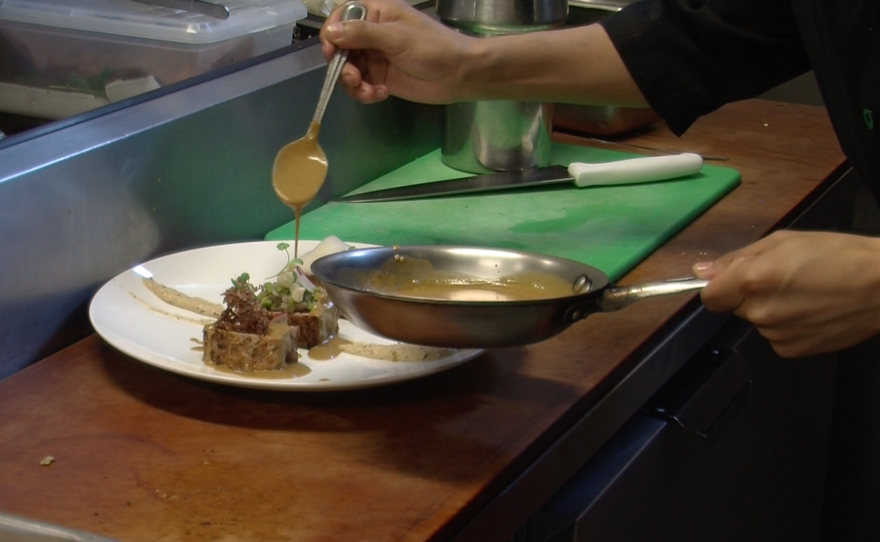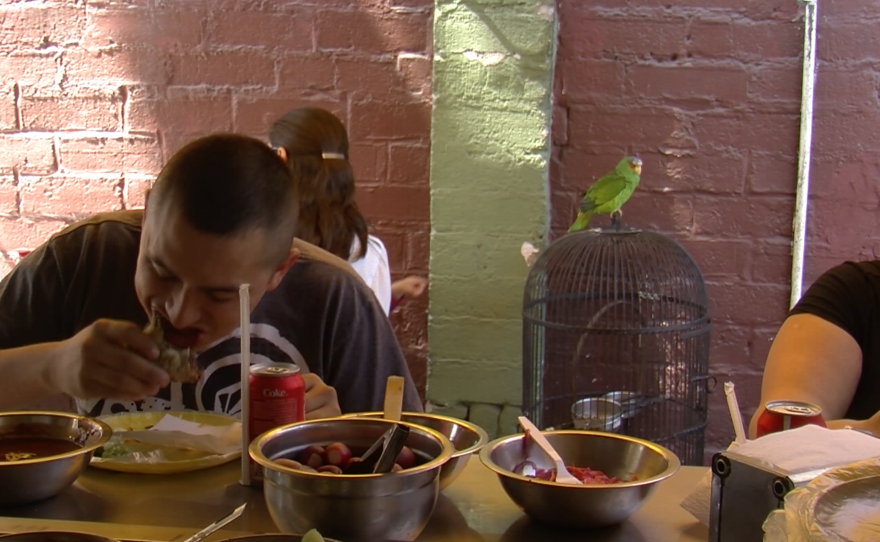On a recent morning in Tijuana, Vladimir Tellez Montaño watched his workers mold blue maize dough for wood-fired tortillas at his restaurant, Verde y Crema.
“All the maize, we bring it in from the south,” Montaño said.
He prefers the blue maize cultivated in Southern Mexico over the more common white or yellow varieties. All his ingredients come from diverse regions of Mexico, he said, "because we want to communicate the migration of cultures this city has. This mosaic of Mexican cultures."

Despite a recent spate of killings in Tijuana, food lovers from San Diego and elsewhere continue to travel to south-of-the-border restaurants like Verde y Crema for culinary creativity.
Tellez said the violence isn't interfering with business.
“We’ve learned to live with this environment of danger. It ends up diluted with cultural stuff like what we have now in food,” he said.
Tijuana is a city of migrants — a place where Mexico’s innumerable culinary styles converge. Verde y Crema serves everything from octopus tacos to ribs and kimchi. “It’s not typical Mexican food but it’s very local, very Baja Californian, and communicates precisely this union of cultures in the city,” Tellez said.
The chefs of Tijuana are harnessing this union of cultures to consistently attract a global clientele, and the strategy seems to be working.
Tellez said the interest of visitors has been shifting from street food to a more high-quality, innovative dining experience, and that's attracting a different kind of food lover – one he said is less likely to be scared off by headlines of violence.
“The quality of our visitors is constantly better," Tellez said. "They’re more intellectually prepared, they’re university students, people who read and know that there are things to accept and things to question about border cities.”
In Tijuana, 70 murders were recorded in May — the highest monthly total in two years, according to Mexican law enforcement officials. For comparison, San Diego County had 74 murders in all of 2014.
History repeats itself
Angel Miron is the owner of a Baja California food and craft beer tour company called Let’s Go Clandestino. He often takes his clients to Verde y Crema, where chefs use a wood-fired oven to cook many of the items on the menu. The olive wood is brought in from the Valle de Guadalupe and chopped every morning.

Miron said the technique gives the food a smoky aroma that has become characteristic of a lot of the Tijuana cuisine. It's what his clients love about Verde y Crema.
He said he started his business because he thought Tijuana should be known for its chefs rather than its violence.
“I wanted to show people it’s safe again to travel to Mexico, to Baja,” he added.
Miron's business hasn't been hurt by the spike in violence, either. He thinks that's because Tijuana's food has become too good to resist.
This isn’t the first time Tijuana’s food has helped compensate for violence-related drops in tourism. Miron said it all started in 2008.
“The violence slowed down, it moved away from this border, so the locals had to, there was no tourism at that time so the locals had to reinvent the city, reinvent the cuisine.”
Tijuana's food king
A restaurant called Misión 19 was central to this reinvention. Owner and chef Javier Plascencia is the food king in Tijuana. Every Tijuana foodie knows his name.
He said the recent violence isn’t hurting business at all.

“I haven’t seen a decrease in tourism. I still get a lot of people, especially on the weekends, to come and dine," he said.
Plascencia said 70 percent of his clients are from north of the border. But he thinks people have learned to accept Tijuana for what it is, saying, “It’s a border city. There’s always going to be that issue of cartels and drugs and smuggling... If you wanna eat real good, authentic, exciting cuisine, then there’s always that danger.”
Tijuana first rose to prominence with foreigners during the Prohibition era. It gained a reputation as a “Sin City” where people went to drink and gamble. Plascencia said the city’s identity is evolving. “Back in the 80s, 90s we had lots of partiers who just wanted to come and drink cheap beer, eat chips and salsa and a few tacos for $10," he said. But now, "I think customers became better eaters. Now there’s tons of foodies and people really interested in good ingredients. In good concepts."
Like Tellez, Plascencia relies on local ingredients. Most of his menu is made up of seafood – seared tuna topped with black mole caramal, crunchy octopus. “We have such an amazing variety of species from the Pacific Ocean and also from the sea of Cortez,” said Plascencia.
It's part of a local-sourcing movement that his customers appreciate. "They want to know where their food comes from … they’re well-informed, they’re well-traveled, they know more.”
There's still an appetite for street food
Plascencia points out that this new species of customer is still interested in classic Mexican tacos. But they have to be good tacos.

Tacos Memo's is among the rising number of food trucks in Tijuana seeking to innovate with the quintessential taco.
“Some people call this place Parrot Tacos,” said owner Dora Lopez. The name comes from her six parrots. She always has one of them on hand to lure visitors.
Lopez said she has customers from California and from other parts of Mexico as far away as Mexico City. People with long layovers at the Tijuana airport come eat here.
“It’s homemade. Everything is homemade. None of it is processed,” said Lopez.
The truck's specialty? Carne asada tacos made with flour tortillas rather than maize tortillas -- a northern Mexico, or norteño tradition.
Customer Manuel Bucardo was enjoying a carne asada taco there on a recent Wednesday.
“Not all of the tacos in Mexico are good," he said. "These are good. They’re once-and-only.”
And Bucardo considers himself a taco connoisseur.
This report is part of KPBS's Fronteras Project, a regional news collaborative that produces reports on the changing culture and demographics of the American West and Southwest. Fronteras reporting is made possible by a grant from the Corporation for Public Broadcasting.






